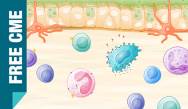
Format
Clinical Review
Time to Complete
45 minutes
START ACTIVITY
MAXIMUM CREDITS
0.75 / AMA PRA Category 1 CreditTM
ACCREDITED PROVIDER
This CME-certified enduring activity is jointly provided by Rutgers Biomedical and Health Sciences and RedMedEd.


COMMERCIAL SUPPORTER
Support for this activity has been provided through an educational grant from Sanofi Genzyme and Regeneron Pharmaceuticals.
PROGRAM DESCRIPTION
As the incidence of asthma—and the number of patients with severe, treatment-resistant asthma—continues to rise, the need for new management strategies has never been greater. Fortunately, several new tailored biologic therapies have recently been developed for certain patients with treatment-resistant severe asthma. The discovery that severe asthma comprises multiple phenotypes and discrete endotypes linked to distinct patterns of airway remodeling and inflammatory pathophysiology holds the promise of enabling clinicians to better target therapies suited for a given patient’s disease.
This interactive activity has been developed to help clinicians identify severe asthma phenotypes and endotypes, adopt strategies for matching patient types with the most effective targeted therapies, and better understand the mechanisms underlying the use of biologic therapy for the treatment of patients with severe asthma.
INTENDED AUDIENCE
This activity has been designed to meet the educational needs of allergists, immunologists, pulmonologists, and primary care providers (including nurse practitioners and physician assistants) involved in the care of patients with severe asthma.
EDUCATIONAL OBJECTIVES
Upon completion of this activity, participants should be better able to:
- Describe the role of cells and cytokines in driving asthma inflammation and endotype expression
- Discuss the main phenotypes and endotypes in severe asthma and their treatment implications
- Summarize the differences between the biologic therapies used in severe asthma treatment
- Evaluate recent clinical advances with the use of biologic therapies in the management of severe asthma and identify the most appropriate candidates for this form of therapy
Source:

